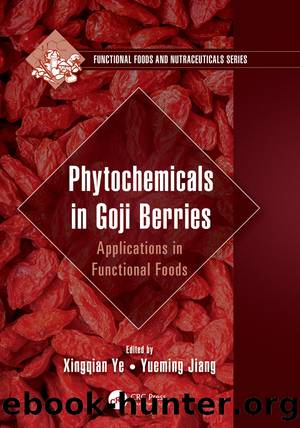Phytochemicals in Goji Berries by Ye Xingqian; Jiang Yueming;

Author:Ye, Xingqian; Jiang, Yueming;
Language: eng
Format: epub
Publisher: Taylor & Francis Group
Published: 2020-06-05T00:00:00+00:00
Table 11.6
Free Radical Scavenging Activities of Goji Berries
ABTS µmol/g
DPPH µmol/g
ORCS µmol/g
FeOH-RSC µmol/g
PhOH-RSC µmol/g
Brand I
54.5
14.3
180
1.3
470
Brand II
60
18.5
260
1.2
590
Brand III
61
13.9
230
1.6
630
11.3.2 In Vitro Cell-Based Antioxidant Function
Long exposure (24 h) of goji berry ethanol extracts has more Hepa 1c1c7 cell protective function than short (30 min) exposure. . In this study, H2O2 had cytotoxicity on Hepa 1c1c7 cells, but dried goji berries produced in the Ningxia Hui autonomous region of China had potent cytoprotective effects on H2O2 toxin-exposed Hepa 1c1c7 cells. Lycii Fructus extract (LFE) increasing the concentration of Nrf2 and AhR in Hepa 1c1c7 cells. Nrf2 and AhR can induce the expression of antioxidants and respectively reduced glutathione- a tripeptide antioxidant and cytochrome p450 Xu et al. (2018). .
N-trans-caffeoyl dopamine is a hydroxyl cinnamic acid amide of goji berries. This has proven to be anti-inflammatory in one in vitro experiment. It decreased lipopolysaccharides induced inflammation in RAW 264.7 cells. Along with these amide derivatives, Wang et al. (2017) also discovered N-trans-caffeoyl dopamine (5), N-trans-feruloyl phenethylamine (6), N-trans-feruloyl dopamine (11) and N-3,4-dihydroxyhydrocinnamoyl tyramine (15) in goji berries. The molecular mechanism of goji anti-inflammatory functions is yet to be elucidated. N-trans-feruloyltyramine (FLA) compound from goji berry decreased the expression of aP2 and JNK signaing in lipopolysaccharide-induced RAW 263.7 cell lines. Jiang et al. (2015) experimentally proven that FLA downregulating the mRNA levels of inducible nitric oxide synthase (iNOS) and cyclooxygenase-2 (COX2). Goji berry extracts also decreased reactive oxygen species formation in human umbilical vein endothelial cells . Wu et al.(2012) explained this molecularly as goji decreasing the NfkB-TF-mediated oxidative stress.
Download
This site does not store any files on its server. We only index and link to content provided by other sites. Please contact the content providers to delete copyright contents if any and email us, we'll remove relevant links or contents immediately.
Should I Stay or Should I Go? by Ramani Durvasula(7436)
Why We Sleep: Unlocking the Power of Sleep and Dreams by Matthew Walker(6370)
Fear by Osho(4499)
Flow by Mihaly Csikszentmihalyi(4496)
Why We Sleep by Matthew Walker(4197)
Rising Strong by Brene Brown(4196)
How to Change Your Mind by Michael Pollan(4116)
Too Much and Not the Mood by Durga Chew-Bose(4103)
The Hacking of the American Mind by Robert H. Lustig(4098)
Lost Connections by Johann Hari(3933)
He's Just Not That Into You by Greg Behrendt & Liz Tuccillo(3720)
Evolve Your Brain by Joe Dispenza(3509)
The Courage to Be Disliked by Ichiro Kishimi & Fumitake Koga(3266)
Crazy Is My Superpower by A.J. Mendez Brooks(3210)
What If This Were Enough? by Heather Havrilesky(3204)
Resisting Happiness by Matthew Kelly(3201)
Descartes' Error by Antonio Damasio(3168)
The Book of Human Emotions by Tiffany Watt Smith(3148)
In Cold Blood by Truman Capote(3143)
